
|
Hawaii Amateur Radio Emergency Service |

|

|
The Amateur Radio Emergency Service (ARES) is made up of Amateur Radio operators, who register their equipment and qualifications with ARES. These operators provide volunteer communications services in times of disaster or civil emergency.
The ARES national organization is comprised of smaller regional organizations, each being within an ARRL Section. This web page serves the Hawaii Section, covering the entire state of Hawaii, managed by the Hawaii ARRL Section Emergency Coordinator (SEC).
Hawaii ARES is segmented into four counties, which are aligned with Hawaii Bureau of Homeland Security Regions. Each county is organized into districts, each having an assigned District Emergency Coordinator DEC) or Emergency Coordinator (EC).
Hawaii ARES members participate in NET (i.e. Network or on-the-air information gathering) operations, exercises and training. These activities may be organized at the statewide, county or district levels.
ARES is open to all Amateur Radio operators. You don't need to be a member of the ARRL to join ARES.
Please join us! Amateur Radio operators can enroll in the Hawaii Amateur Radio Emergency Service by selecting the Register New Member menu item under the Members menu on this page.
More information is located here, at the bottom of this page.
|
Hawaii ARES has been fortunate to garner the support of a successful CERT EmComm project based in Walnut Creek, California. The project is based on the Winlink software operating in a simplex VHF radio only environment. The team leader is John Trinterud (K9ONR). He is making available to Hawaii ARES his digital message formats (Winlink templates) and a clear explanation of how they moved a paper only system to a graphical map-based system in small steps over a few years. Here is an overview of the presentation. “During a major disaster, communications are critical, but the internet and other communications channels such as cell service are likely to be inoperable or overwhelmed. Walnut Creek CERT designed, built, and deployed a city-wide, amateur radio based digital email system (Winlink), that is amateur radio and CERT specific, robust, independent of commercial services including power and Internet, and tailored to the City’s EOC requirements for reporting and system security. It is integrated with GIS (Geographical Information Systems) capabilities for automatic mapping of incidents and includes automatic log and report traceability, all with open-source free software. This presentation describes and demonstrates the system.” Here is a link to the streaming video of the most recent presentation made to Maui Civil Defense, Walnut Creed CERT Presentation to Maui Civil Defense “John Trinterud (K9ONR) has a background of 55+ years in communications, telephony, computer operations, UNIX software support, organic farming, and organic inspections (!). John was first licensed in 2012 as KJ6PAP; now holds a General Class license and graduated from Walnut Creek CERT after 10 years. He now serves as a Technical Specialist in the ARRL East Bay Division, concentrating on all things Winlink. He covers all phases from initial system designs through configuration, training, and ongoing technical support.” Interest in the technology among Hawaii hams led to John launching a “Winlink Mapping Course”. The first session was oversubscribed so a second one is being considered, assuming enough interest. If you are interested, this link explains the course and how to register. |
|
The EMCOMM-Training Group held their second nationwide Semi-Annual Peer to Peer Winlink exercise an Saturday, 12 November 2022. This exercise was an extension of the Thursday ETO Winlink Training exercises held weekly through the year. The purpose of the exercises and of the EMCOMM-Training-Group is to train operators in using Winlink’s many message handling elements and to demonstrate the amateur radio community’s ability to provide accurate and timely messaging over radio only paths using Winlink. The scenario for the Saturday drill was an asteroid that hit Earth’s atmosphere, broke up into many fragments, and these fragments caused widespread damage on impact. Participating amateurs prepared and submitted a Field Situation Report and an ICS-213 form answering specific questions posed by the dill masters. For the Peer-to-Peer exercise held Saturday, participating stations were asked to submit their exercise messages via a group of 34 target stations located throughout the mainland United States, Puerto Rico, and Hawaii. These stations were strategically assigned operating frequencies that covered 80 – 15 meters. One target station, AH6T, operated on 40 meters (7118 dial) between the hours o 06:00 and 18:00 HST in support of Hawaii’s participants. A total of 13 Hawaii stations submitted messages:
All amateurs are encouraged to learn to use Winlink by taking advantage of the weekly exercises sponsored by the EMCOMM TRAINING GROUP (http://www.emcomm-training.org/) and the bi-weekly Winlink exercises sponsored by Hawaii ARES (nh7it@arrl.net). |
|

Saturday, October 15, 2022, Great ShakeOut will be held between 9 a.m. and 10 a.m. HST. This will be a Winlink exercise only for those who have Winlink capability. The exercise will be based on a real 6.2 earthquake that occurred last year off the Big Island that was felt throughout the State. However, this exercise scenario will be located inland in the Volcano National Park. A simulated 7.2 moment earthquake will occur at 8:55 a.m. HST resulting in various simulated damages on the Big Island and felt throughout the State of Hawaii. No simulated local tsunami will be generated. The exercise objective for Hawaii Hams, who have Winlink capability:
Hint: The closer you are to the epicenter of the simulated earthquake, the stronger the effects of the simulated quake should be reported as well as simulated damages should also be reported on the DYFI form. No exercise injects will be sent out. The USGS DYFI form can be found in Winlink Express, click on Message, click on New Message, click on Select Template, under Standard Templates, scroll down to USGS, then click on USGS DYFI.txt The DYFI form is attached below. Mode to be use will be VARA FM, VARA HF, Packet, Pactor, or Telnet. Hope those with Winlink capability will be able to participate in this easy exercise. It should take less than ten minutes to complete and then you are done. Last year we had all four counties were represented and thirty-seven radio operators participated. Let's see if we can exceed last year's participation. Have fun with this exercise. In a real earthquake, remember to duck, cover and hold on! Example DYFI form is located here: DYFI_example_form |
Click here for documentation about the exercise
More information on the flyer below, and you can also download the flyer
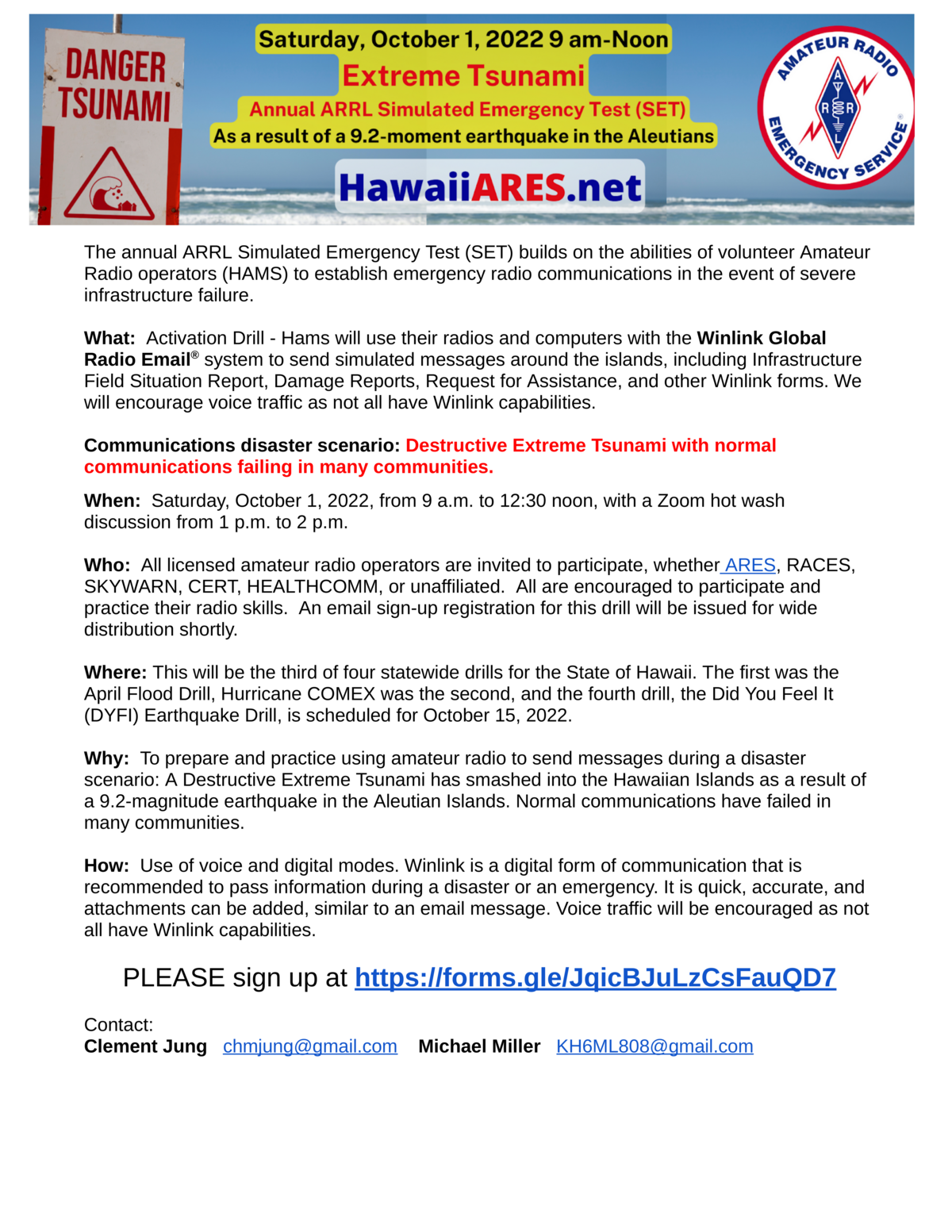
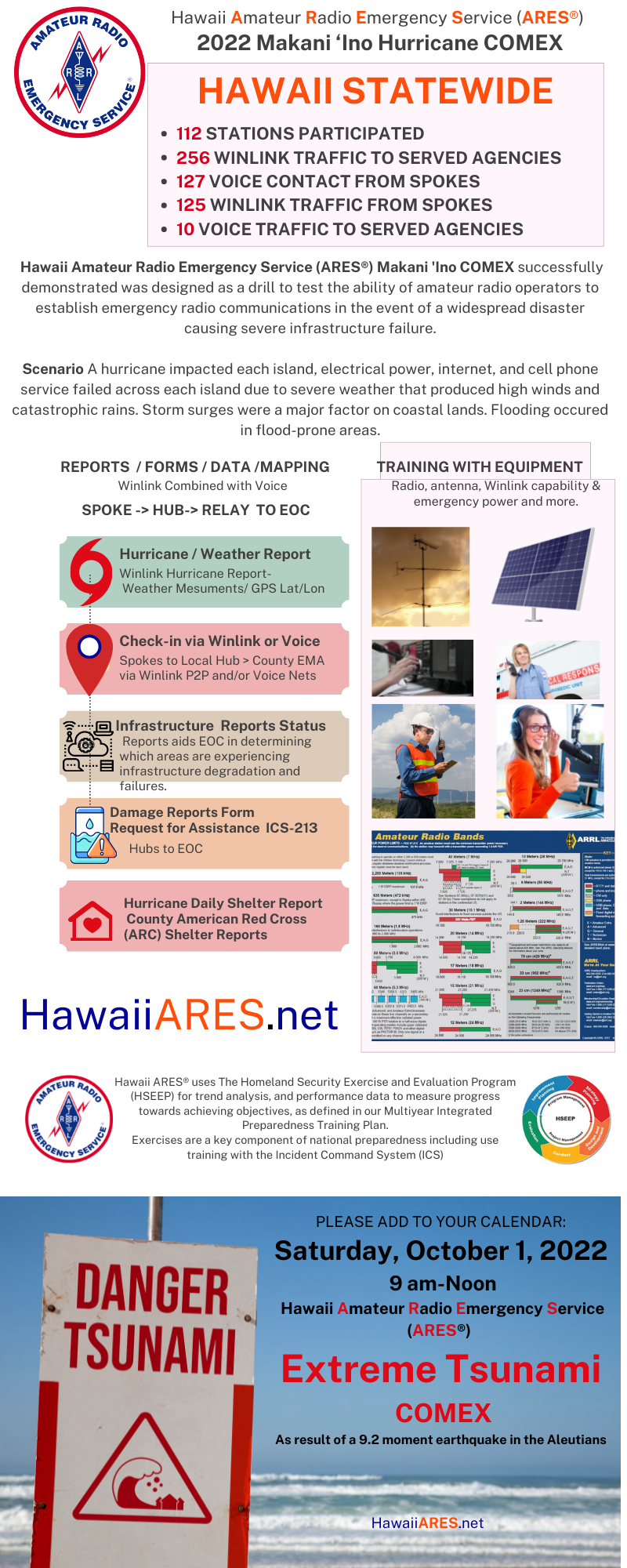
Read the full After Action Report (AAR) here
Updated July 6, 2022
KHON2 had a June 22 video report on our upcoming Hurricane drill. Click here to view the video.
KITV4 did a more general story on Amateur Radio on June 29, that included coverage of the Hurricane drill. Click here to view it.| Salem Media of Hawaii FM Radio PSA - |
 for website and PR (YouTube Thumbnail).png)
Makani 'Ino is a drill to test the ability of volunteer Amateur Radio operators (HAMS) to establish emergency radio communications in the event of severe infrastructure failure. Hams will use their radios and computers with the Winlink Global Radio Email®️ system to send simulated messages around the islands including Winlink Hurricane Reports, Check-Ins, Check-Outs, Field Situation Report, Damage Reports, Request for Assistance, and Red Cross Shelter Reports.
Using Winlink "...we can actually send emails both locally all-around Oahu, neighbor islands as well as nationally, internationally, to help different served agencies..." said Miller (KH6ML) on KITV. Miller underscored that amateur radio does not rely on the infrastructure that may be disrupted. During the Makani 'Ino exercise on July 16th, radio operators will "start on voice and then send simulated digital messages of hurricane damage, and move on to shelter reports, and requests for assistance."
The Hawaii Amateur Radio Emergency Service (ARES®) training EXERCISE is Saturday, July 16th, 2022, from 9 am to noon.
Click here for a link to an index with participant material for your district.Read more details and the full press release here.
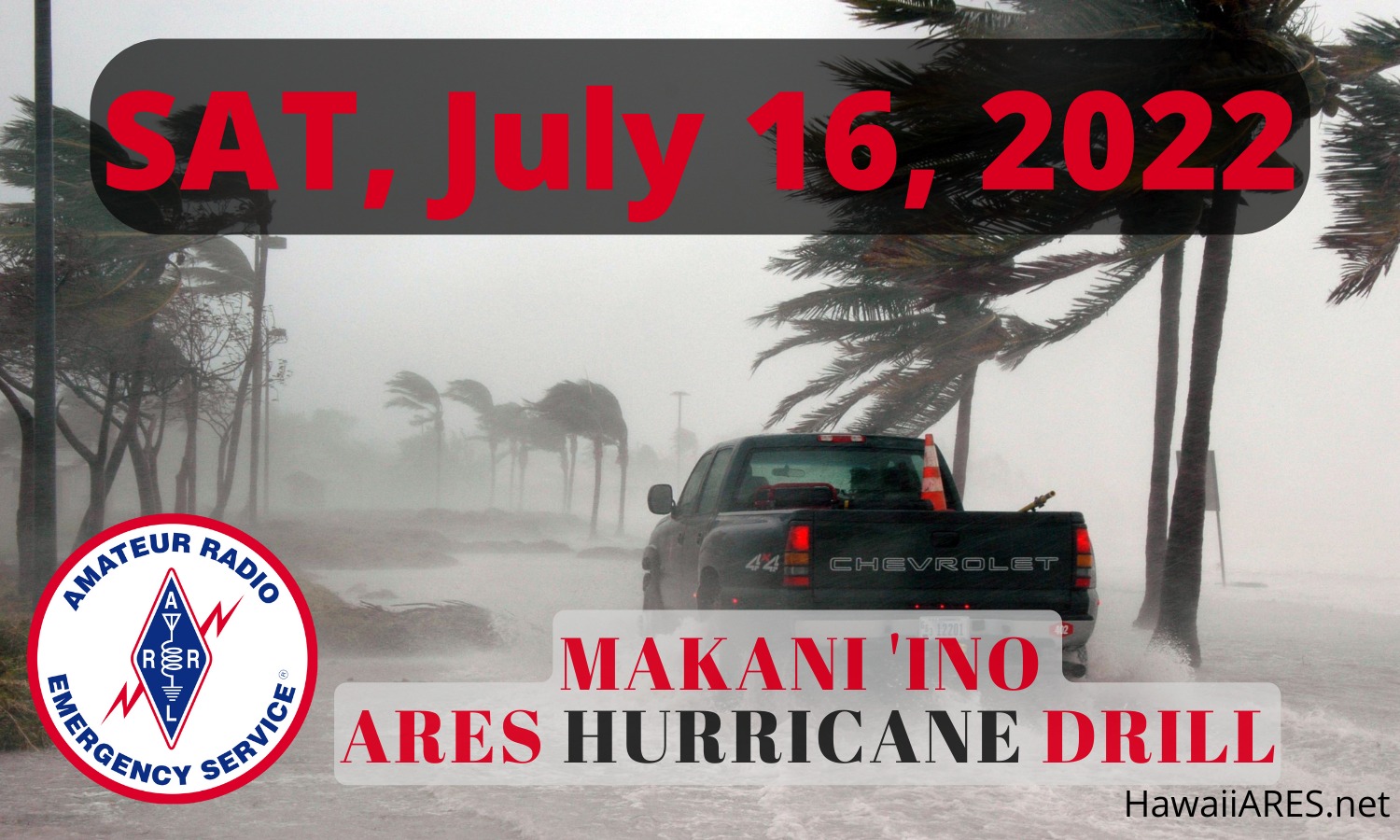
When: Saturday, July 16, 2022 from 9 a.m. to 12 noon
Who: All licensed amateur radio operators are invited - unaffiliated or with ARES, RACES, SKYWARN, CERT, HEALTHCOMM, or any club. We will encourage voice traffic as not all have Winlink capabilities.
Where: State of Hawaii.
Why: To prepare and practice using amateur radio to send messages during a catastrophic hurricane when normal communications have failed.
How: Use of voice and/or digital mode, Winlink, to pass Winlink Hurricane Reports, Check Ins, Check Outs, Field Situation Report, Damage Reports, Request for Assistance, Shelter Reports
Shortened Scenario - See full drill at https://www.emcomm-training.org/drills2.html A single volcanic vent spewing ash into a sprawling cloud several miles into the sky. Strong ashfall is affecting As cascading power failure and communications issues that has spread across much of the nation.
Amateur radio has been asked to help with this reporting health and infrastructure from the impact of the ash.
DHS, NWS, and USGS have become increasingly concerned with the impacts on both health and infrastructure from the impact of the ash. They are looking for the public to report conditions across the nation.
The EmComm Training Organization (ETO)has been asked to have its members report their infrastructure, weather conditions, and ash conditions across the US and Canada by Winlink. Areas without reliable internet access can also use the peer-to-peer part of Winlink to achieve these results.
This is a great time for amateur radio to show its capability to report information in an environment when many other traditional systems are unavailable.
Purpose
The purpose of the Nationwide ETO (EmComm Training Organization) semi-annual communications drill is to demonstrate the ability of Amateur Radio to provide accurate and timely messaging by forms using email over radio (Winlink) to further the mission of the agencies and organizations that we serve.
This can involve partners including the Amateur Radio Emergency Service (ARES), Radio Amateur Civil Emergency Service (RACES), Auxiliary Communications Service (ACS), along with many other government agencies and non-government organizations. As accuracy and reproducible documents are a cornerstone of modern disaster communications, the primary emphasis will be on digital written forms of communications, as opposed to verbal.
Objectives
HAWAII ARES MEMBERS - Here is a chance to TEST your Skills and Equipment. Armed Forces Day (AFD) cross-band military with amateur radio!
Schofield Barracks, Hawaii will be one of the many stations making two-way radio contacts. If you make contact please send an email to KH6ML808@gmail.com, With a note on how it went!
A detailed list of modes and frequencies for military/government stations taking part in the Armed Forces Day Cross-Band Test and information on the AFD message is available at www.dodmars.org. In the upper right corner is a dropdown with all the information.
The US Department of Defense will host this year's Armed Forces Day (AFD) Cross-Band Test on Saturday, May 14. While Armed Forces Day is May 21, the AFD cross-band military-amateur radio event traditionally takes place 1 week earlier to avoid any conflict with the Dayton Hamvention®. The event is open to all radio amateurs.
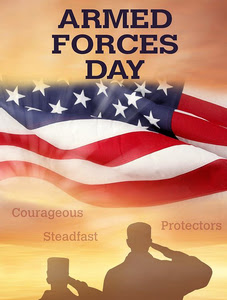
The AFD Cross-Band Test is two-way communications exercise between military and amateur radio stations, as authorized under FCC Part 97 rules (47 CFR § 97.111), and Department of Defense Instruction 4650.02 which establishes the Military Auxiliary Radio System (MARS). During the exercise, radio amateurs listen for stations on military operating frequencies and transmit on frequencies in adjacent amateur bands.
ARRL The National Association for Amateur Radio® has promoted the participation of military and amateur radio stations in the AFD event for more than 50 years. In the August 1950 issue of ARRL's membership journal, QST, it was noted that "232 persons made perfect copy of the 'Greeting to Amateurs' broadcast at 25 w.p.m. over 13 military frequencies and have received a Certificate of Merit signed by the Secretary of Defense, the Honorable Louis Johnson."
There are 24 military stations registered across the United States, including Alaska and Hawaii, that will be participating in the 2022 event. Several of those stations will be using the 60-meter interoperative channels during this exercise. All operations will be on a not-to-interfere basis, in case there are real-world missions being supported during the event timeframe.
An AFD Secretary of Defense message will also be sent in CW and RTTY, and an AFD message will also be transmitted utilizing the Military Standard (MIL-STD) serial PSK waveform (M110), followed by MIL-STD Wide Shift FSK (850 Hz RTTY), as described in MIL-STD 188-110A/B.
Complete the request form to obtain a QSL card at www.usarmymars.org/armed-forces-day-qsl-card-request.
More information available in this pdf.
Mar 14, 2022
The upcoming Kawailani 'Ino Hawaii Excerise (April 16, 2022) was featured in a Hawaii News Now news segment on Mar 14, 2022. You can click the image or the link below to find out more.
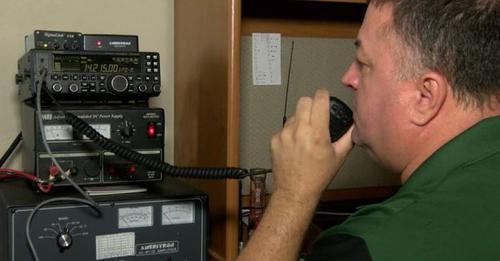
Hawaii News Now - In a worst-case scenario, these amateur radio operators could offer a communication lifeline
It's not too late to sign up for the exercise, more infomation in the section below the link
Click here to sign up for the April 16th ARES COMEX
Read the full After Action Report (AAR) here
Read the full After Action Report (AAR) here
From the Press Release issued on Feb 26, 2022
Hawaii Amateur Radio Emergency Service (ARES®) will conduct a training EXERCISE on April 16th, 2022 between 9 AM and Noon that will exercise and train using the Incident Command System Structure. This EXERCISE will simulate a 4-day period of catastrophic rain and wind covering the Hawaiian Islands from Kauai to the Big Island with loss of power, internet and cell towers in order to train ARES® members and non-members in radio operations and procedures.
Click here to read the full press release.
There is also a flyer about the exercise.
If you will be able to participate, please feel free to signup for this COMEX. All licensed Amateur Radio operators in Hawaii are invited to participate. Local operations are coordinated through your local CEC/DEC and a planning team member on each island. All operations are organized under the Incident Command System (ICS) through the development of an Incident Action Plan. (IAP) The IAP is a collection of ICS forms such as the ICS-201 Incident Briefing, ICS-202, 203, 204, 205, etc. This exercise was developed using guidance from the Department of Homeland Security Exercise and Evaluation Program (HSEEP).
Last updated Mar 29,2022 --- More information about this exercise is located here - this includes county specific ICS forms and information for the participants.
The nationwide Amateur Radio Relay League Simulated Emergency Test (SET) occurred on the first Saturday of October 2, 2021. This year, Hawaii radio operators provided damage reports to simulated county emergency management/Civil Defense agencies as result of a simulaed 9.2 moment earthquake in the Aleutians which resulted in a Great Aleutian tsunami or an extreme tsunami which caused simulated damages to all the counties in the State of Hawaii.
For this exercise, the simulated tsunami had already arrived. All repeaters, including Winlink gateways, were operational.
The purpose of this communication exercise was to verify our ability to operate using the digital protocols developed as well as voice communications to pass messages.
Radio operators were requested to use auxiliary power, e.g., batteries, solar panels, generators, if available.
The objectives were for each radio station to transmit three Winlink messages using the following Winlink forms (Hawaii county used their two county Hawaii County Civil Defense Agency forms in place of the Winlink forms - Check-In, ICS-213, Check-Out
The following Winlink modes were used to send messages - Telnet, VARA FM, VARA HF, VARA HF Peer to Peer, Pactor, Packet and AREDN Mesh. Hub and Spoke concept were used to forward messages. Voice messages were also used.
Messages were sent to the respective simulated county emergency management/Civil Defense agency. County ARES District Emergency Coordinators informed the radio operators in their counties where to send the above messages.
Below are the results of this year's SET:
What went well:
What were the challenges:
What could be improved:
All four counties were represented: Total 58 (3 were as NCS) radio operators participated, and 157 messages sent:
The following radio operators participated:
| Kauai: four (4) | |||||||||||||||||||||||||||||||
| NH7YS | WH6BS | WH6HI | WH6TR | ||||||||||||||||||||||||||||
Oahu: twenty-eight (28)
| AB7RT |
KH6FHI |
VE3SDU |
WH6CMO |
AH6CP |
AH6IX (NCS) |
AH6Q |
AH6QO |
KH6DQ |
KH6EN |
KH6LT |
KH6ML |
KH6MOI |
KH6TOD |
KH7HO |
KH7O |
NH7IT |
NH7J |
WH6CPH |
WH6ECG |
WH6EKM |
WH6EKU |
WH6FPL |
WH6FPL |
| WH6FVG | WH6FWF | WH6KM | WH7PD (NCS) | |||
| Maui: five (5) | |||||||||||||||||||||||||||||||
| KH6H | KH6UU | WH6AV | WH6E | ||||||||||||||||||||||||||||
| WH7EZ | |||||||||||||||||||||||||||||||
| Hawaii: twenty-one (21) | |||||||||||||||||||||||||||||||
| AH6AE | KH6CZ | KH6DK | KH6DO | ||||||||||||||||||||||||||||
| KH6EKD | KH6RDO | KH6TD | KH7DQ (NCS) | ||||||||||||||||||||||||||||
| KH7LM | KK6GM | NH7UA | WH6DVI | ||||||||||||||||||||||||||||
| WH6DZH | WH6FQI | WH6FQQ | WH6FSD | ||||||||||||||||||||||||||||
| WH6FZH | WH6GDC | WH6GG0 | WH6LC | ||||||||||||||||||||||||||||
| WH7BR | |||||||||||||||||||||||||||||||
In summary, the 2021 SET was successful with the three Winlink and the two Big Island County forms sent successfully. A total of 58 (including 3 NCS) radio operators participated and 157 messages were sent and received!
The Hawaii Great ShakeOut was held Saturday, October 16, 2021, between 9 a.m. to 10 a.m. HST. This annual event is normally held on the third Thursday of October. However, to increase Hawaii Amateur participation we held it on an earlier Saturday. This is the second time Hawaii participated in this annual event.
The exercise was based on the recent 6.2 earthquake that occurred around 10:58 a.m. on Sunday, October 10, 2021, off the Big Island felt throughout the State. However, this simulated exercise was located inland in the Volcano National Park. The simulated 7.2 earthquake resulted in various simulated damages on the Big Island and felt throughout the State of Hawaii. It occurred at 8:50 a.m. HST and Hawaii Hams started reporting to the U.S. Geological Survey (USGS) using the Winlink DYFI form beginning 9 a.m.
The objective was for Hawaii Amateur Radio operators throughout the State to submit a Winlink DYFI (Did You Feel It) template with simulated responses per their location from the center of the simulated earthquake. Digital email modes used were VARA FM, VARA HF, Packet and Telnet.
Amateur Radio operators used the Winlink RF email system to submit reports directly to the USGS main computer system USGS has developed an interface to support Amateur Radio reports for simulated and real events.
Below is the list of the thirty-seven Hawaii radio operators from all four counties who submitted a report to the USGS computer system.
| AB7RT | AH6AE | AH6IX | AH6Q | AH6QO |
| KH6CP | KH6CZ | KH6DQ | KH6EKD | KH6EN |
| KH6FHI | KH6H | KH6HHG | KH6LT | KH6OWT |
| KH6RDO | KH6UU | KH7HO | KH7ML | KK6GM |
| NH6M | NH7IT | NH7J | NH7UA | NH7YS |
| VE3SDU | WH6CMO | WH6CPH | WH6ECG | WH6EKU |
| WH6EPS | WH6FLO | WH6FPL | WH6FQI | WH6FSD |
| WH6KM | WH7EZ |
Mahalo to the above radio operators who submitted their DYFI reports. Feedback from USGS management indicated appreciation for our participation, helping them develop their automated reporting software.
This year's Hawaii Great ShakeOut will be this coming Saturday, October 16, 2021 from 9 a.m. to 10 a.m. HST.
For those who have Winlink capability, please participate in this very short exercise. You can sent it in whatever mode, e.g., VARA FM, VARA HF, Packet, Pactor, or Telnet if you are not in range of a gateway. Please do not submit before 9 a.m. However, once you submit your DYFI, you are done. The scenario is similar to yesterday's 6.2 earthquake but will be a 7.2 earthquake in the Volcano National Park. How extensive your damage report will depend how far your location is from the simulated Hawaii Volcano National Park. The simulated earthquake will be felt throughout the State and may cause major simulated damages as you do your report in the DYFI form.
Here is a link to the Hawaii Great ShakeOut 2021 instructions - http://HawaiiARES.net/HI Great ShakeOut 2021.pdf
Please follow the instructions, especially the Exercise ID and adding the additional information in the Additional comments at the bottom of the DYFI form. Also, please CC the message to KH7HO. This instruction will also be on the hawaiiares.net web site shortly.
Hoping many Hawaii Hams will participate and show USGS how Hawaii Hams will support DYFI and the Great ShakeOut this year.
Have fun with this exercise.
Remember, in a real earthquake to duck, cover and hold on!
Purpose
The nationwide ARRL Simulated Emergency Test occurs the first Saturday of October
every year. This year Hawaii ARES is having EMCOMM stations provide simulated
damage assessment reports to simulated county emergency management agencies.
This year's scenario is a 9.2 moment earthquake in the Aleutians leading to an extreme tsunami causing damages to all the counties in the State of Hawaii. Participating Amateur Radio operators should be aware of the closest extreme tsunami evacuation zone to their operating location and what damages could be expected. Information can be found by checking with your respective county emergency management or Civil Defense agencies or in the yellow pages.
For this exercise, the tsunami has already hit, and we are reporting damages. All repeaters, including Winlink gateways, will be operational.
The purpose of this COMMUNICATIONS EXERCISE is to verify our ability to pass messages using the digital protocols, as well as voice communications.
Click here for complete instructions.
Purpose
The purpose of this exercise is to demonstrate the ability of Amateur Radio operators to
provide accurate and timely messages via Winlink. This exercise is open to all licensed Hams
whether they are with ARES, RACES, HealthComm, SKYWARN, CERT, or unaffiliated. We
encourage all Hams to participate as we prepare for this year’s hurricane season.
Objectives
• Amateur Radio stations to be able to compose and successfully send three properly
completed Winlink forms using Winlink email over radio; however, the use of Telnet is
acceptable for those with no access to a Winlink gateway or computer interface to a
radio.
• Amateur Radio stations to be able to operate in a simulated shelter using emergency
power, e.g., generators or batteries with or without solar panels; however, we
encourage radio operators to participate even if they cannot operate off the electrical
grid.
Exercise Scenario
A destructive category 4 hurricane has developed in the central pacific. It is named Makani and
has sustained winds of 150 mph with gusts of over 200 mph. It is approaching south of the
Hawaii island and will move northward on the west side of the state, impacting all islands.
Exercise Activity and Timeline
This communication exercise (COMMEX) will be on Saturday, June 19, 2021. The overall
exercise timeline will be from 9 a.m. to 12 noon HST.
Radio operators living in the following counties will send their messages to KH7HO using
Winlink:
• City & County of Honolulu
• Kauai
Radio operators living in the following counties will send their message to KH6FHI using
Winlink:
• Maui
• Hawaii
We will simulate as shelter radio operators for this exercise. You are encouraged to operate away from your Ham shack in the following suggested locations:
• At home in your back yard/garage;
• If you operate at your Ham station at home, use battery or a generator; if no alternate
power source, can still operate using the electrical grid;
• Mobile in your vehicle;
• Setup in a community center parking lot;
• Setup in a park parking lot;
• Setup near a school, or with permission, in the school parking lot.
Note: Please exercise care as we are still faced with COVID-19.
Again, to encourage all licensed Amateur Radio operators to participate, if you do not have mobile or an auxiliary power source, you can still operate from the electrical grid. We encourage the use of hub and spokes and encourage CERT groups to participate in this exercise. Voice messages are acceptable but will need to be converted to the Winlink templates and sent via Winlink.
For more details on this exercise, and to view the exercise message requirements, please click here.
Purpose:
To demonstrate the ability of Amateur Radio to provide accurate and timely messaging using Winlink forms to further the mission of the Red Cross. This can involve Red Cross communication leads, as well as ARES, RACES, Auxiliary Communications Service. The primary emphasis will be on digital forms of communications. Objectives:
◦ Amateur radio stations will compose and send forms using the Winlink email over radio to Red Cross divisional clearinghouse (ARCHI)
◦ Increase Red Cross awareness of the Amateur Radio capability to assist in their mission
◦ Prepare and train Amateur Radio operators to effectively use the Winlink system
◦ Determine weaknesses that future training can address
National and Worldwide:
◦ 722 unique callsigns
◦ 862 Check-In messages received at all eight divisional clearinghouses
◦ 782 properly filled Check-In forms
◦ 15 international participants
Hawaii:
◦ 38 callsigns (1 did not use any forms)
◦ 44 Check-In messages received; 7 duplicates
◦ Modes:
◦ VARA FM – 26
◦ VARA HF – 8
◦ Packet - 1
◦ Pactor – 1
◦ Other – 1
The Following Hawaii Hams participated in the Spring Drill
▪ AH6OO; AH6AE; AH6IX; AH6JA; AH6KO; AH6QO
▪ KH6CP; KH6CZ; KH6DQ; KH6EKD; KH6EN; KH6FHI
▪ KH6FV; KH6HHG; KH6LT; KH6ML; KH6OWL; KH6RDO
▪ KH7LM; KH7O; KK6GM; NH6XL; NH7IT; NH7J; NH7UA; NH7YS
▪ VE3SDU; WH6ABM; WH6CPH; WH6DVI; WH6ECG; WH6EKU
▪ WH6FQI; WH6FSD; WH6FZH; WH6GGO; WH6GLD; WH6KM
For more information and to see pictures of hams with their operating stations, please click here to see the full report.
The spring Red Cross nationwide emergency communications drill will be held on Saturday, May 8th, with Red Cross, ARES and other operators asked to demonstrate the ability to deliver digital messages using Red Cross forms to specific addresses via Winlink. For this exercise, participants are tasked with sending two messages to the Red Cross Divisional Clearinghouse for their geographic area. The exercise scenario and guidelines attached to this message provide details and instructions for operators desiring to participate. This exercise draws on lessons learned in the previous Winlink Thursday sessions. For those who have been following along, this scenario gives you the opportunity to put into practice the skills you have been practicing since January. You will need to send a Winlink Check-In Form to register your participation and a separate WInlink message with a template ARC Disaster Requisition Form 6409. The hand-written sample provided in the exercise packet is similar to one that might be handed to a radio operator supporting a Red Cross relief operation. We urge everyone to take their time and be sure the information transcribed into the Winlink template form is an accurate copy of the information supplied on the form and that each message is properly addressed to the recipients specified in the directions.
A new addition to our playbook is the inclusion of a real-time map that displays the location of each station as their Winlink Check-In Form is received. You can follow along and watch as the exercise progresses on Saturday by clicking here to view the map. Please submit your messages on Saturday, May 8th between noon and 4 p.m. local time.
For those who can do so safely, we encourage you to once again pack your "go-kit" and get out in the field to submit your exercise traffic. This is good practice for any operator looking to become proficient in EmComm operations.
Last month, many of you submitted photos of your go-kit in the field as an attachment to your Winlink message. For this iteration, in order not to tie up the Winlink gateways unnecessarily, we request that anyone looking to submit an image to share in our gallery do so by sending it via traditional email to photos@ARC-EmComm-Training@groups.io Do not send images using Winlink in this exercise.
This year our spring exercise falls on World Red Cross and Red Crescent Day, an annual celebration of the principles of the International Red Cross and Red Crescent Movement. World Red Cross Red Crescent Day is celebrated on May 8th each year. This date is the anniversary of the birth of Henry Dunant, who was born on 8 May 1828. He was the founder of the International Committee of the Red Cross (ICRC) and the recipient of the first Nobel Peace Prize. We have set up a special clearinghouse for amateur radio operators from other national Red Cross or Red Crescent societies to check in for this event using the Winlink tactical address ARCDX.
If you would like to be included in our future training and exercise sessions, visit our website at ARC-EmComm-Training.org and subscribe to our mailing list. You can also find additional information on suggested proficiency goals and training materials to help you broaden your skills as an amateur radio operator.
In 2020, more than 80 AREDN MESH nodes were deployed in Hawaii. As done on the mainland, Amateurs connect their stations via a private Amateur Radio network. Here’s a link to the current Hawaii network, https://tinyurl.com/y56ox3wu The AREDN MESH network is self-configuring. A node added to the network broadcasts its identity to all the other nodes. Installation is truly well designed and easy to use. The ability to deploy go kits with AREDN MESH radios that are added dynamically makes it one more digital tool to pass traffic.
Mastering the technology allows us to build networks around our islands. We can be less dependent on access to high places. Hawaii AREDN MESH is not an Internet ISP. We can ring our islands with many short hops that provide multiple paths from one node to another.
The basic component needed for a short hop is the AREDN MESH router, a MikroTik hAP. The term hAP stands for home Access Point. It is really just an Internet home router that has been “flashed” to operate in the Amateur Radio private network. As Amateur Radio equipment goes, it is inexpensive. About $50 on Amazon!
With a hAP connected via Internet, Amateurs can begin learning about the Hawaii network. The next step is to add a microwave link to become more independent of Internet. A pair of MikroTik SXT 5.8 GHz radios can be added to access a “sector node” in his area or interconnect two Amateur’s stations via microwave. One of these can be had for about $70.
The IEEE recently hosted a ZOOM meeting that brought a lot of information to Hawaii Amateurs. Stephen Minakami (NH6XL) setup the meeting. We are fortunate that he was able to arrange a member of the AREDN MESH organization, Orv Beach (W6BI), who gave a great overview of mainland networks and the hardware and software components building the network. Here is a YouTube link to Orv’s talk.
Following his talk, Gessie Alpuro (WH6AV) gave an overview of AREDN MESH in Hawaii. As of now AllStar repeaters and seventeen Hawaii gateways are already connected via Hawaii AREDN MESH. It is amazing how well developed the network has become.
One of Gessie’s focus has been interconnecting AllStar and Winlink gateways on the Big Island. hAP, SXT and point to point hardware has been donated to BIARC members to get the network started. He is working with Oahu as well as with his own island. Jim Pilgram (NH6HI) is driving the progress on Kauai. This is truly an all-Hawaii project. Here is a link to Gessie’s YouTube,
Hawaii ARES now supports Winlink and AREDN MESH use in its exercises. Previously Clem Jung (KH7HO) made arrangements with the Hawaii Amateur Radio Emergency Digital Radio Network, Inc. (HEARDn.org) a 501C3 corporation, to provide audio adapters and VARA software licenses at a reduced cost to interested Amateurs. He now also has HEARDn support for AREDN MESH components.
If interested in adding digital modes to your Amateur Radio station, contact Clem to see how ARES can help Amateurs interested in either of these digital technologies.
This drill was an exercise in sending messages from local sites to a group of American Red Cross Divisional Clearinghouses to simulate and demonstrate the capability of amateur radio operators across the country to relay information in times of need.
The drill used the messaging program Winlink as the primary method of delivering preformatted messages. Amateur radio operators were free to utilize any connection mode available - HF, VHF, UHF and Telnet.
The goal was to encourage more operators to become familiar with Winlink and the message templates within.
Click here for the exercise instructions
A total of 60 station participated in the event. Here's a phto collage of particpants who enjoyed participating!
 |
Click here for After Action Report
Click here for the exercise statistics
For the first time, Hawaii Amateur Radio stations have been invited to participate in the national Great ShakeOut on Thursday, October 15, 2020, at 10:15 HST. This is an annual event occurring on the third Thursday of October. Participating organizations including schools, churches, non-profit organizations, submit reports using Internet.
With the increase of Hawaii Winlink stations, we have the opportunity to submit useful reports using Amateur Radio.
| Click here for USGS Hawaii DidYouFeelIt exercise instructions |
USGS Sent Appreciation for Particpating Hawaii Stations (Rev B) |
The nationwide ARRL Simulated Emergency Test occurs the first Saturday of October every year. This year Hawaii ARES is simulating deployment of EmComm stations to shelters statewide providing reports to American Red Cross shelter managers directly to the Red Cross email system.
The purpose of this COMMUNICATIONS EXERCISE is to verify our ability to deploy equipment to shelters and operate using the digital protocols developed in conjunction with Hawaii State Red Cross.
| Click here for Hawaii exercise instructions |
Click here for exercise statistics (Rev D) |
The Amateur Radio Emergency Service (ARES) is made up of Amateur Radio operators, who register their equipment and qualifications with ARES. These operators provide volunteer communications services in times of disaster or civil emergency.
The ARES national organization is comprised of smaller regional organizations, each being within an ARRL Section. This web page serves the Hawaii Section, covering the entire state of Hawaii, managed by the Hawaii ARRL Section Emergency Coordinator (SEC).
Hawaii ARES is segmented into four counties, which are aligned with Hawaii Bureau of Homeland Security Regions. Each county is organized into districts, each having an assigned District Emergency Coordinator DEC) or Emergency Coordinator (EC).
Hawaii ARES members participate in NET (i.e. Network or on-the-air information gathering) operations, exercises and training. These activities may be organized at the statewide, county or district levels.
ARES is open to all Amateur Radio operators. You don't need to be a member of the ARRL to join ARES.
Please join us! Amateur Radio operators can enroll in the Hawaii Amateur Radio Emergency Service by selecting the Register New Member menu item under the Members menu on this page.
ARRL membership is not required to become a member of ARES. Any Amateur Radio licensee may register as an Hawaii ARES member. There are no registration fees or dues associated with ARES membership.
Amateur Radio operators may participate in training in order to obtain qualifications beyond that of holding an Amateur Radio license. Such qualifications enable an Amateur Radio licensee to participate in Hawaii ARES at a higher level of service. Hawaii ARES Amateur Radio operators are encouraged to obtain additional training.
The primary sources for Amateur Radio operators to obtain qualified training include both the ARRL and the Federal Emergency Management Agency (FEMA) Emergency Management Institute. Training resources for both of these organizations can be found under the Training menu on this page.
Recommended training includes:
|
|
Additional training opportunities are listed under the Activities menu on this page.
Amateur Radio's role in Public Service Communications and Emergency Communications is declared within the purpose of Amateur Radio defined in the Code of Federal Regulations:
CFR Title 47, Part 97.1
Basis and purpose.
The rules and regulations in this part are designed to provide an Amateur Radio service having a fundamental purpose as expressed in the following principles:
From a practical, and operational perspective, Amateur Radio provides several resources and capabilities to Incident Commanders. Among these are:
A pool of fixed, mobile and portable stations that can augment communications systems, or to put in place a communications system where non exists, such as providing communications with disaster evacuation locations.
Communications infrastructure, with a wide range of capabilities, that can be used in place of other failed infrastructure.
Amateur Radio is not a replacement for Public Safety or governmental agencies, but acts to serve agencies in a subordinate capacity. It enables Public Safety agencies to focus on their primary role, maintaining critical Public Safety radio services.
Amateur Radio is particularly well suited to serve logistical communications requirements of an Incident Command and to provide communications that can be used as a replacement for failed public communications infrastructure. It can provide communications services to non-governmental agencies, such as the Red Cross, in time of disaster. It is to these missions that the Hawaii Amateur Radio Emergency Service is committed.